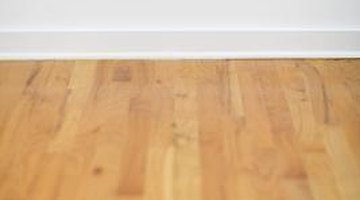Staining Yellow Birch Flooring
Yellow birch is one of the more challenging wood species to stain, and if you're using it for flooring, you may need to use a variety of stain techniques instead of just one. If you simply wipe on a stain, as you would for an oak floor, the final result may be unacceptably blotchy. Techniques that work with birch include spraying dyes, applying toner coats, and glazing by adding pigment to a clear finish.
Characteristics of Yellow Birch

Yellow birch grows in the northeastern United States and in the Canadian Maritime provinces, as well as in Quebec, Ontario and Manitoba. The wood that comes from the tree has a Janka hardness rating of 1260, which is slightly less than red oak. It has a mostly featureless grain, with sapwood colors ranging from pale white to creamy yellow and reddish-brown heartwood. Besides being durable, yellow birch is highly workable, and commonly is used to make cabinets and interior woodwork, as well as flooring. The grain is porous in places, however, and soaks up stains unevenly.
Preparing for Staining
Like any hardwood, birch needs to be carefully sanded before it accepts stain evenly. For flooring, this means opening the grain with 50-grit or coarser sandpaper, then refining the surface with successive passes with 80- and 100-grit paper. In order to use a conventional penetrating oil stain and avoid blotchiness, it's advisable to first condition the wood. Commercial wood conditioning products often contain a small amount of finish material, such as shellac, in a dilute solvent solution. The finish seals the wood so stain doesn't penetrate as deeply. You typically brush or wipe on conditioner, and apply the stain after it dries.
Coloring With Dye
After conditioning the wood, another strategy for achieving uniform color on birch is to use a dye colorant. Dye dissolves in the solvent that carries it instead of remaining as a suspension, like the pigment in most wood stains. It penetrates deeply and evenly when you spray it, using air spray equipment or even a garden sprayer, and let it dry without wiping it. To deepen and unify the tone, you can follow this treatment with an application of pigment-based wood stain, brushing or wiping it on, and wiping off the excess with a rag.
Toning and Glazing
Toning or glazing refers to the process of adding pigment to the finish material. When applied over dye or stain, this tinted finish further tones the color, but that color often ends up being quite dark. An alternative is to apply the pigmented finish as a glaze directly over the first coat of sanding sealer. Because it sits on the surface, it provides a uniform color tone you can darken, if desired, by adding subsequent coats. Always cover a glaze with at least two protective clear coats to prevent chipping. When a glaze chips, it reveals bare, uncolored wood underneath.
References
Writer Bio
Chris Deziel has a bachelor's degree in physics and a master's degree in humanities. Besides having an abiding interest in popular science, Deziel has been active in the building and home design trades since 1975. As a landscape builder, he helped establish two gardening companies.
Photo Credits
- Jupiterimages/Brand X Pictures/Getty Images
More Articles


